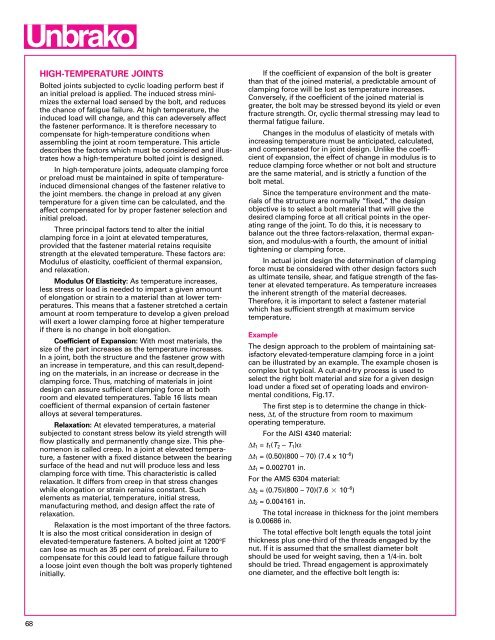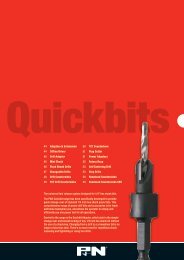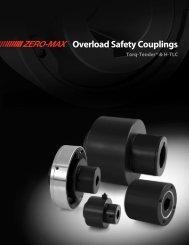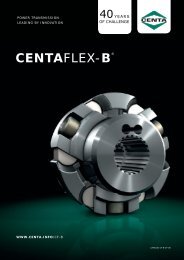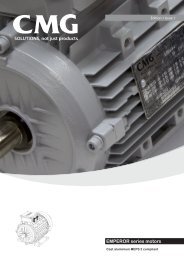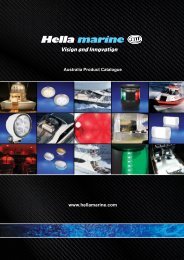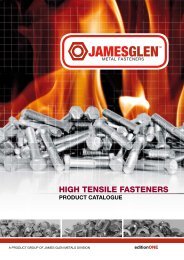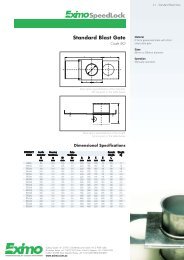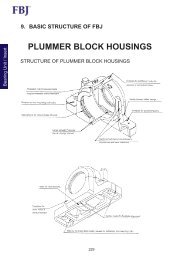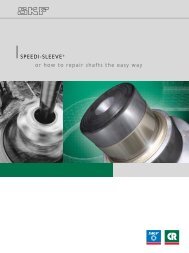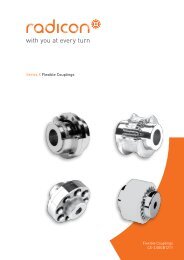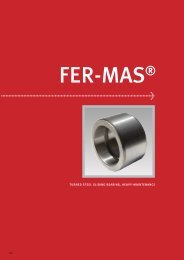Socket Products Engineering Guide - Industrial and Bearing Supplies
Socket Products Engineering Guide - Industrial and Bearing Supplies
Socket Products Engineering Guide - Industrial and Bearing Supplies
- No tags were found...
Create successful ePaper yourself
Turn your PDF publications into a flip-book with our unique Google optimized e-Paper software.
HIGH-TEMPERATURE JOINTSBolted joints subjected to cyclic loading perform best ifan initial preload is applied. The induced stress minimizesthe external load sensed by the bolt, <strong>and</strong> reducesthe chance of fatigue failure. At high temperature, theinduced load will change, <strong>and</strong> this can adeversely affectthe fastener performance. It is therefore necessary tocompensate for high-temperature conditions whenassembling the joint at room temperature. This articledescribes the factors which must be considered <strong>and</strong> illustrateshow a high-temperature bolted joint is designed.In high-temperature joints, adequate clamping forceor preload must be maintained in spite of temperatureinduceddimensional changes of the fastener relative tothe joint members. the change in preload at any giventemperature for a given time can be calculated, <strong>and</strong> theaffect compensated for by proper fastener selection <strong>and</strong>initial preload.Three principal factors tend to alter the initialclamping force in a joint at elevated temperatures,provided that the fastener material retains requisitestrength at the elevated temperature. These factors are:Modulus of elasticity, coefficient of thermal expansion,<strong>and</strong> relaxation.Modulus Of Elasticity: As temperature increases,less stress or load is needed to impart a given amountof elongation or strain to a material than at lower temperatures.This means that a fastener stretched a certainamount at room temperature to develop a given preloadwill exert a lower clamping force at higher temperatureif there is no change in bolt elongation.Coefficient of Expansion: With most materials, thesize of the part increases as the temperature increases.In a joint, both the structure <strong>and</strong> the fastener grow withan increase in temperature, <strong>and</strong> this can result,dependingon the materials, in an increase or decrease in theclamping force. Thus, matching of materials in jointdesign can assure sufficient clamping force at bothroom <strong>and</strong> elevated temperatures. Table 16 lists meancoefficient of thermal expansion of certain fasteneralloys at several temperatures.Relaxation: At elevated temperatures, a materialsubjected to constant stress below its yield strength willflow plastically <strong>and</strong> permanently change size. This phenomenonis called creep. In a joint at elevated temperature,a fastener with a fixed distance between the bearingsurface of the head <strong>and</strong> nut will produce less <strong>and</strong> lessclamping force with time. This characteristic is calledrelaxation. It differs from creep in that stress changeswhile elongation or strain remains constant. Suchelements as material, temperature, initial stress,manufacturing method, <strong>and</strong> design affect the rate ofrelaxation.Relaxation is the most important of the three factors.It is also the most critical consideration in design ofelevated-temperature fasteners. A bolted joint at 1200°Fcan lose as much as 35 per cent of preload. Failure tocompensate for this could lead to fatigue failure througha loose joint even though the bolt was properly tightenedinitially.If the coefficient of expansion of the bolt is greaterthan that of the joined material, a predictable amount ofclamping force will be lost as temperature increases.Conversely, if the coefficient of the joined material isgreater, the bolt may be stressed beyond its yield or evenfracture strength. Or, cyclic thermal stressing may lead tothermal fatigue failure.Changes in the modulus of elasticity of metals withincreasing temperature must be anticipated, calculated,<strong>and</strong> compensated for in joint design. Unlike the coefficientof expansion, the effect of change in modulus is toreduce clamping force whether or not bolt <strong>and</strong> structureare the same material, <strong>and</strong> is strictly a function of thebolt metal.Since the temperature environment <strong>and</strong> the materialsof the structure are normally “fixed,” the designobjective is to select a bolt material that will give thedesired clamping force at all critical points in the operatingrange of the joint. To do this, it is necessary tobalance out the three factors-relaxation, thermal expansion,<strong>and</strong> modulus-with a fourth, the amount of initialtightening or clamping force.In actual joint design the determination of clampingforce must be considered with other design factors suchas ultimate tensile, shear, <strong>and</strong> fatigue strength of the fastenerat elevated temperature. As temperature increasesthe inherent strength of the material decreases.Therefore, it is important to select a fastener materialwhich has sufficient strength at maximum servicetemperature.ExampleThe design approach to the problem of maintaining satisfactoryelevated-temperature clamping force in a jointcan be illustrated by an example. The example chosen iscomplex but typical. A cut-<strong>and</strong>-try process is used toselect the right bolt material <strong>and</strong> size for a given designload under a fixed set of operating loads <strong>and</strong> environmentalconditions, Fig.17.The first step is to determine the change in thickness,∆t, of the structure from room to maximumoperating temperature.For the AISI 4340 material:∆t 1 = t 1 (T 2 – T 1 )α∆t 1 = (0.50)(800 – 70) (7.4 x 10 –6 )∆t 1 = 0.002701 in.For the AMS 6304 material:∆t 2 = (0.75)(800 – 70)(7.6 10 –6 )∆t 2 = 0.004161 in.The total increase in thickness for the joint membersis 0.00686 in.The total effective bolt length equals the total jointthickness plus one-third of the threads engaged by thenut. If it is assumed that the smallest diameter boltshould be used for weight saving, then a 1/4-in. boltshould be tried. Thread engagement is approximatelyone diameter, <strong>and</strong> the effective bolt length is:68


